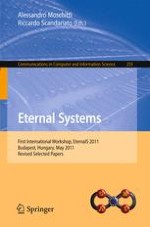This book constitutes the refereed post-proceedings of the First International Workshop on Eternal Systems, EternalS 2011, held in Budapest, Hungary, in May 2011. The workshop aimed at creating the conditions for mutual awareness and cross-fertilization among broad ICT areas such as learning systems for knowledge management and representation, software systems, networked systems and secure systems, by focusing on their shared objectives such as adaptation, evolvability and flexibility for the development of long living and versatile systems. The 6 revised full papers and 4 short papers presented were carefully reviewed and selected from 15 submissions. They are organized in topical sections on software and secure systems, machine learning for software systems, and ontology and knowledge representations.
